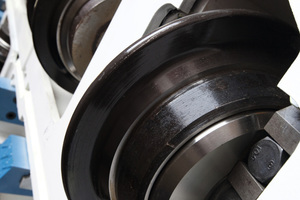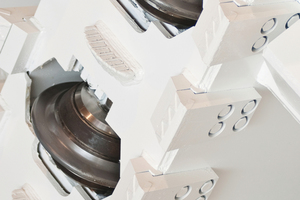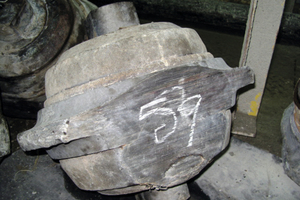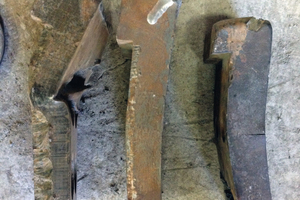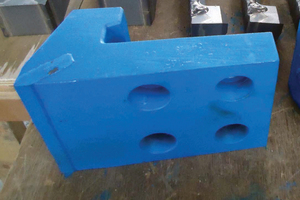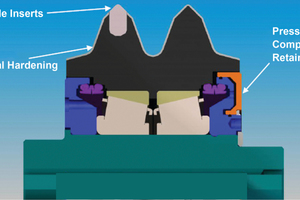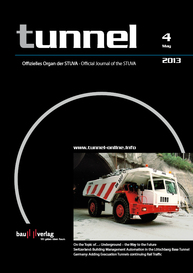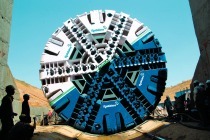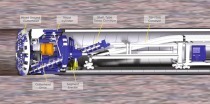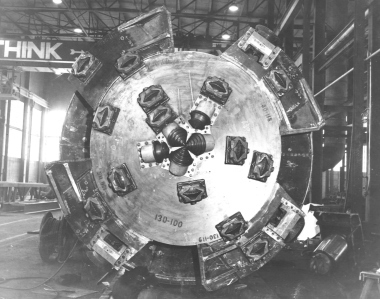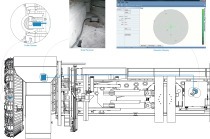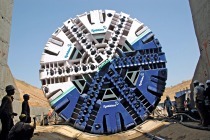The Next Revolution in EPB Cutters – New Cutter Designs make an Impression in Mixed Ground
The 62 km long Emisor Oriente Wastewater tunnel can only be called an epic tunneling endeavour. Located at depths of up to 150 m below the surface and at 6 bar water pressure with tough mixed ground conditions including basalt, clay, sand and large boulders, a fact that made TBM excavation the only viable option. It is projects like these that are ushering in a new era of cutting tools –from cutterhead setups to monitoring devices to high pressure cutter discs, new EPB cutters aim to limit interventions and speed excavation (Figs. 1 and 2). Deep EPB and hybrid TBM projects in mixed conditions are becoming more common, and with that new leaps forward in cutter research are needed.
Six TBMs including three Robbins EPBs are tackling on this project in the underground of Mexico. The emergency project is needed urgently to prevent potential flooding of Mexico City’s wastewater into the downtown area.
Disc Cutters vs. Carbide Bits: Selecting the Proper Cutting Tools
Disc cutters and knife bits are the primary tools of choice for EPB applications with various other add-on tools supporting the functioning of these primary tools.
The choice of cutting tool is dependent on the geology from the outset, but may also change during the tunnel operation. The important point is to be adaptable and accept that circumstances may change during excavation.
Disc Cutters
Disc cutters have shown over many years of use to be the best choice of cutting tool for breaking rock into smaller pieces for easy removal. There are many styles of discs available and many options for the configurations of those discs on the cutterhead.Disc cutters were first invented for breaking rock and have the longest life of any cutting tool in rock. When disc cutters are used in soft ground, though, their full life may not be achieved. The normal wear mechanism on disc cutters is abrasive wear and during normal operation, the ring will wear equally around the circumference. When the disc cutter doesn’t roll, as frequently occurs in soft ground, only one side of the ring slides along the face and flat spots occur, decreasing ring life (Fig. 3).
Knife Bits
The term knife bit refers to any type of cutting tool which has a stationary edge aligned so that the long edge is oriented circumferentially with the cutterhead. This tool breaks up areas of consolidated or semi-consolidated soft ground for removal by a screw conveyor in an EPB type machine.
Similar to disc cutters, the primary wear mechanism on knife bits is also abrasive wear. Carbide tips are usually used in knife bits because of the excellent abrasion-resistance of carbide material. Carbide inserts are often used in disc rings as well, but care must be taken when using carbide-inserted disc rings because carbide is quite brittle and can crack if high-impact loads are experienced (Fig. 4). For this reason, solid steel is the material of choice for disc rings when the ground is expected to be blocky. In addition to using carbide inserts in knife bits, hard-facing should be added to the supporting material in order to extend the overall life of the piece. This reduces the wear of the softer underlying material that holds the carbide tips.
Interchangeable Tools
Mixed-face EPB cutterheads are designed to accept either disc cutters or knife bits. The tools are interchangeable and can be swapped out to best match changing conditions. In the ideal situation, a project would contain distinct sections of rock and soft ground. The selection of the cutting tool for each zone would be obvious, and interventions would be planned for swapping of cutting tools.
In reality, this scenario is rarely possible or practical. Frequently, rock and soils alternate along a tunnel alignment or both are present at the same time in front of the machine. Knife bits have the ability to cut rock, but not efficiently, and disc cutters are recommended for rock with a Uniaxial Compressive Strength (UCS) of 20 MPa or higher. Much to the chagrin of the tunnelling industry, no tool has proven able to match the performance of disc cutters in rock and knife bits in soft ground.
Additional Cutting Tools
Besides disc cutters and/or knife bits, additional tools are needed to encourage muck flow, protect cutterhead structures, and monitor for excessive wear. These tools typically use carbide inserts and hard-facing to increase the wear resistance. Scrapers are used to route the loose soils into the cutterhead chamber (Fig. 5). Various protection bits are used to prevent wear on the cutterhead and accessories, including injection ports, the periphery of the cutterhead, and the bodies of the disc cutters. Special wear detection tools can alert the operator when a wear threshold has been exceeded.
Reducing Interventions with Cutter Wear Detectors and Ground Conditioning
Wear of cutting tools is a fact of life on TBMs and wear in EPB applications, in particular, is higher than in either hard rock or slurry applications. Use of ground-conditioning additives reduces the abrasive characteristics of the soil by improving the flow of the material. Addition of hard-facing to the cutting tools improves the wear resistance.
All soft ground machines should have tools installed on the cutterhead that can simulate wear of the cutting tools and alert the operator if excessive wear is occurring. These wear detection tools cannot take the place of regular inspection and maintenance but they can alert the operator to a problem between maintenance periods.
One of the more common methods for detecting wear is by use of a wear detection bit plumbed hydraulically to a pressure sensor. The wear detection bit has a hole drilled to a pre-determined wear level and when the tool wears to this point, the hydraulic pressure is lost, which will show an alarm. Ideally, this tool should be similar in construction to the tool that it is trying to measure, which usually means it will use carbide inserts and be hard-faced with the same material as the knife bits.
New Developments: Cutters for High-Pressure Conditions
Though some designs for high pressure cutters used in conditions of plus 3 bar exist in the industry, their effectiveness is limited in certain conditions. These established designs work well on slurry machines, but have historically had problems on EPBs. The cutters operate properly as the pressure increases in an EPB tunnel, but if the pressure decreases the cutter housings can easily become jammed with fines and disable the pressure compensating mechanism. Robbins engineers hope, with a novel design, to specifically eliminate problems that can occur when using pressure compensated cutters on EPBs.
Pressure compensated designs being field-tested include cutters with a two-piece end retainer that transmits external pressure to the inside of the cutter, zeroing out the differential pressure across the cutter seals. The device minimizes the risk of a cutter seal failure, which can happen if standard cutters are used in these conditions. Cutter seal failures allow contaminants to breach the inner cutter structure, causing the cutter bearing to fail. Because the seals are the limiting factor in these conditions, engineers are additionally testing high pressure seals as a parallel path to pressure compensation.
The new pressure compensated designs have been tested in a sealed pressure vessel environment, which simulates a high-pressure environment using compressed air or water and an internal test cutter assembly. A drive motor rotates the assembly to simulate real-world cutter rotation.
The higher cost of these specialized cutters is offset by the longer cutter life and reduced number of cutter changes. The cutter cross section depicts a cutter with the pressure compensating retainer and which also uses carbide inserts in the cutter body with hard-facing (Fig. 6). The moveable pressure compensator is represented by the orange piece. This piece is in contact with the lubricating oil inside the cutter and transmits external pressure to the inside to balance the forces on either side of the seal. Pressure-compensating pistons have been installed on the insides of the cutter shafts in the past but these tend to plug in an EPB environment. The use of the two-piece retainer with larger surface area reduces the chances of material blocking pressure transmission.
New Developments: Improved Cutter Profiles and Beyond
Internal mechanisms are not the only aspects of soft ground cutters that are being redesigned. Cutter bits are being re-worked with optimized profiles and fabrication techniques, while EPB-specific disc cutters are getting a new design as a smaller total package. The tighter footprint of each cutter assembly will allow for slimmer cutterhead spokes and less steel in the cutterhead structure. The increased open area results in a smoother muck flow and less abrasive wear to cutterhead elements.
Robbins engineers currently employ a soft ground tool wear predictor which estimates wear based on general geology and the model is being refined based on reports from multiple jobsites.
There’s Always Room for Improvement
While the future of disc cutters is a bright one, engineers and researchers agree that there are several areas that need improvement and could benefit from more research. The TBM should be looked at as an entire package, where optimizing the machine can help to aid in cutter performance. While optimization of the complete design of the disc cutter itself is important, an ideal design also takes into account a proper cutterhead layout from placement of the cutters, to the number of cutters on the cutterhead and their distance in relation to each other. It is also critical that operators know how to drive the TBM without damaging the disc cutters.
Mixed Ground
In mixed ground, there is still room for improvement in current designs. The most difficult terrain for TBM tunneling is mixed ground. Disc cutters naturally don’t want to rotate in soft ground and can wear flat. Meanwhile, impact loading from rock or boulders can damage carbide cutting tools, making both types of tools at risk in these conditions. Use of different tool heights, such as disc cutters that protrude slightly farther than the cutter bits to crush boulders, doesn’t always work. The boulders can still contact other cutting tools and cause damage before they are small enough to be brought into the cutterhead chamber. More development is needed to remedy these specific problems that can affect any EPB in mixed ground.

